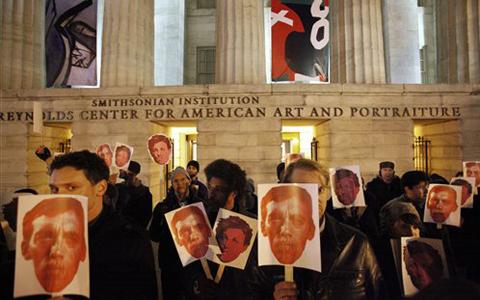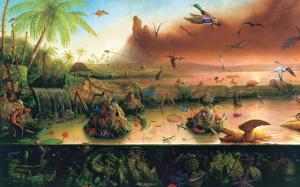
STEVE EMBER: I'm Steve Ember.
BARBARA KLEIN: And I'm Barbara Klein with EXPLORATIONS in VOA Special English. Today we visit two museums housed in one building in Washington, DC. The Smithsonian American Art Museum recently opened a show on the New York artist Alexis Rockman. His colorful paintings are influenced by an interest in science and a deep concern for environmental issues.
We also discuss the "Hide/Seek" exhibit at the Smithsonian National Portrait Gallery. This show about sexual difference has recently received a great deal of public attention and criticism.
(MUSIC)
STEVE EMBER: The full name of the Smithsonian's exhibit is "Hide/Seek: Difference and Desire in American Portraiture." The exhibit opened October 30th. It is the first major exhibit to explore the role that sexual identity has played in modern paintings and photographs of people.
The exhibit is filled with important works by a wide range of artists. Many artworks deal with the subject of homosexuality. Many of the artists are gay men and women. Critics have praised the exhibit's art and its brave subject matter.
BARBARA KLEIN: But members of a Catholic rights organization had a very different reaction to the show. The group voiced its criticism of a video work by New York artist David Wojnarowicz. He was a respected artist who died of AIDS in 1992.
The disputed video is called "A Fire in My Belly." It expresses the artist's view of the suffering and destruction caused by AIDS.
The Catholic League objected to an eleven-second part of the video. It shows insects crawling on a small crucifix representing Christ on the cross. The group said the video was anti-Christian and represented a form of hate speech. The Catholic League has no official or financial connection to the Catholic Church.
Catholic League leader William Donahue brought the issue to the attention of lawmakers. Conservative lawmakers soon began calling on the Smithsonian to close the exhibit. They said tax dollars should not be spent to support such art. One lawmaker threatened to cut the Smithsonian's funding.
About 70 percent of the Smithsonian Institution's budget comes from federal money. But the "Hide/Seek" exhibit was funded entirely with private money.

On December 1st, leaders of the Smithsonian ordered that the video by David Wojnarowicz be removed from the exhibit. Many people criticized the museum for lacking courage and giving in to political pressure.
The Transformer gallery in Washington quickly found a copy of "A Fire in My Belly" and showed the video in its main window so people in the street could view the images.
People demonstrated in front of the National Portrait Gallery, holding pictures of the artist, David Wojnarowicz. One protestor said that removing the video was an attack on the American people. He said lawmakers were saying Americans are not smart enough to make their own decisions about what art to see.
BARBARA KLEIN: One member of the Smithsonian's group of advisors resigned from his position in protest. James Bartlett said that museums have the right to make decisions about exhibits, even if some art is considered objectionable by critics. He said he could not be part of an organization that ignores that right.
Washington Post art critic Blake Gopnik also criticized the Smithsonian's decision. He said a great museum is a laboratory where ideas get tested, not a building filled with dead thoughts. And, he said the real reason officials removed the video is because of the exhibit's main subject, gay love.
The Andy Warhol Foundation was a leading financial supporter of the exhibit. On Monday, the foundation demanded the reinstatement of the video or it said it will stop giving money to Smithsonian exhibitions.
The Smithsonian has said that it supports the exhibit. But it says it removed the video because it was taking attention away from the rest of the show.
(MUSIC)
STEVE EMBER: For more than 20 years, artist Alexis Rockman has been exploring environmental issues in his paintings. His works deal with subjects including biology, genetic engineering, pollution and climate change. They aim to raise awareness about the condition of our planet. His detailed paintings are large, shiny and colorful.
BARBARA KLEIN: The Smithsonian American Art Museum exhibit is called "Alexis Rockman: A Fable for Tomorrow." The name of the exhibit comes from the opening of the book "Silent Spring" by Rachel Carson.
This book was published in 1962. It helped raise public awareness of the dangerous use of chemicals to kill insects and the pollution of the environment. Ms. Carson imagines a future America in which all the birds, plants, and fish have died as a result of human activity. Her commentary is based on real facts and possibilities.

Alexis Rockman also combines facts with imagination in his work. Some works are extremely realistic and based on observations he makes in nature.
He spends a great deal of time researching the science behind his paintings so that every detail is correct. But many works also include imaginary creatures in environments that seem to come from a science fiction movie.
BARBARA KLEIN: An early work is called "Balance of Terror." It is based on an agricultural display from the American Museum of Natural History in New York City. It shows the inside view of a big green apple. A large mealworm is eating through the center of the apple.
Baby insects are also digging their way through the apple. A Venus flytrap plant is ready to catch a nearby fly. The yellow and green colors give the painting a strange and upsetting mood.
STEVE EMBER: Like many of his early works, this one borrows directly from nature. Rockman often shows nature as defined by a struggle for survival with a never-ending repetition of life and death.
As a child, Alexis Rockman often visited the American Museum of Natural History. Many of the exhibits influenced his work. He was also influenced by American landscape painters of the 19th century.
BARBARA KLEIN: You can see these influences in one of the most striking paintings in the exhibit. It is called "Evolution." The huge painting measures nearly two and a half meters in height and over seven meters in length. There are more than 200 different creatures in this painting, both real and imaginary.
Some are from the ancient past, such as dinosaurs, while others still exist on Earth. There are animals in the sky, on land and in the water. Looking at this painting is like watching an action-filled movie about the animal kingdom.
The 47 artworks in the exhibit show how the artist's work has changed over the years. Many of his later works deal with the tensions between nature and humans.

One series of paintings is called "Biosphere." Rockman imagines a terrible future in which plants and animals must be sent into space to protect them from Earth's pollution. For example, "Biosphere: Orchids" shows six white flowers floating all alone in deep space.
BARBARA KLEIN: The painting "Airport" shows a huge jet engine in which a bird has met a violent death. In the background, birds fly around and near other planes, possibly ready to meet a similar end. "The Farm" looks at how genetic engineering has changed agriculture. It shows a field of soybeans, a plant that is commonly genetically modified in the United States.
"The Farm" also shows a hugely fat pig and cow, rectangular shaped vegetables and a chicken with three sets of wings. The painting looks at how science is changing the foods that we produce.
STEVE EMBER: Alexis Rockman has said technology is not the problem. The artist says the problem is corporate America and the effects of globalization. He says the results of using these new technologies are destructive because of the unknowable effects. Rockman says his art is a way to bring attention to America's environmental, economic and political policies and their results.
BARBARA KLEIN: His huge painting "Manifest Destiny" brings to life one possible result. It shows the Brooklyn area of New York City hundreds of years in the future.
The Brooklyn Bridge and other buildings are in ruins, completely underwater. Waste floats in the water. The sky is a poisonous orange color. But nature has not been completely destroyed by humans. Birds and fish still live and survive in this world, although humanity does not.
STEVE EMBER: Alexis Rockman's paintings show great skill and the powerful beauty of the natural world. But they also force visitors to think about the future and consider the importance of the decisions our society makes today.
BARBARA KLEIN: This program was written and produced by Dana Demange. I'm Barbara Klein.
STEVE EMBER: And I'm Steve Ember. Our programs are online with transcripts and MP3 files at voaspecialenglish.com. And you can find us on Twitter, Facebook and YouTube at VOA Learning English. Join us again next week for EXPLORATIONS in VOA Special English.
Venus flytrap: a small carnivorous bog plant with hinged leaves that spring shut on and digest insects that land on them; Native to the southeastern US, it is also kept as an indoor plant. 捕蝇草
Sleeping Beckham makes art debut
As the world turns: exploring the art of wood
All-American artist inspires Lucas, Spielberg
(来源:VOA 编辑:崔旭燕)
